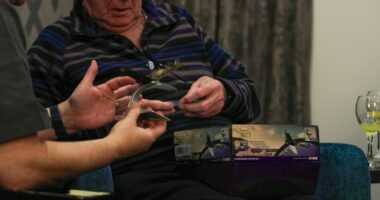Share this @internewscast.com
A mother-of-one is urging people not to ignore mysterious marks on nails after what she thought was a simple bruise turned out to be a deadly form of cancer.
Laura Jennings, 40, from Leeds, first noticed a dark streak beneath her toenail in April 2022.
‘I’m fairly active and can be clumsy at times, so I figured I’d kicked something,’ she said.
‘It certainly didn’t look like anything I should be worried about, and it wasn’t painful, so I kept it covered with nail varnish and carried on as normal.’
When the nail eventually began to crumble, Ms Jennings booked a telephone consultation with her GP—and sent photos.
She was initially diagnosed with a fungal nail infection and given antifungal ointment, and she was told it could take up to a year for a new nail to grow.
But a year later, the dark mark looked worse—prompting Laura to push for a face-to-face appointment.
This time, the GP immediately recognised it as something more serious.

Laura Jennings, 40, thought she knew all the warning signs of cancer.

Ms Jennings first noticed the bruise under her nail in April 2022, but thought nothing of it. It turned out to be a deadly form of skin cancer.
Tests confirmed she had acral lentiginous melanoma, a rare and dangerous form of skin cancer that appears under nails or on the soles and palms.
Ms Jennings has since had part of her toe and a lymph node in her groin removed in a bid to stop the cancer from spreading.
Nearly three years on, she still faces another three years of regular scans before doctors can confirm she’s in the clear.
Recalling the moment of her diagnosis, Ms Jennings said: ‘I just went into a state of shock. My whole body was shaking. I’m a solo parent.
‘I’ve got a little boy and a lot of living to do.
She added: ‘I like to think I’m fairly intelligent and pay attention to health-related campaigns.
‘I know if there is blood in my poo or a lump in my boobs or if a mole starts to itch, bleed or change colour, I know to get those things checked out.
But no one ever tells you to look out for this.’

Signs of skin cancer range from innocuous to obvious, but experts warn that treating cases early is key to making sure they do not spread or further develop
Within a month, Ms Jennings underwent surgery to remove her nail and as much of the tumour as possible. The confirmation of cancer left her devastated.
The road to recovery called for further surgery, resulting in part of her toe being amputated to remove the cancerous cells.
Ms Jennings also had a lymph node in her groin removed to test if the cancer had spread.
As she awaited the results, Ms Jennings grappled with the deepest emotional strain of her journey.
‘My mind was the challenge,’ she said.
‘I was taking my son to swimming lessons, wondering if that was going to be the last one I would take him to.
I couldn’t help thinking, “What if I don’t see him through school? What if I’m not here for him if he gets married? What if I never get to be a grandma?”
‘It was like my body had turned against me. I’d never been so scared that my life could be taken away without me wanting it,’ she added.
Ms Jennings’ tests showed that the surgery was successful, and the cancer had been removed. There were also no signs that the cancer had spread.
However, the single mother now faces five more check-ups over the next three years before she can be considered cancer-free, and even then, there is no guarantee it won’t return.
Melanoma is the UK’s fifth most common cancer, as well as the deadliest form of skin cancer.
In Britain, there are approximately 17,500 new cases diagnosed annually—around 48 every day, according to Cancer Research UK.
Nine in 10 cases are caused by ultra-violet radiation from the sun and sunbeds.
Acral lentiginous melanoma accounts for three per cent of melanoma diagnoses, and while the exact cause remains unknown, sun exposure is not thought to be a factor.
Ms Jennings is sharing her story to highlight the important of taking skin changes seriously—and seeking medical advice if you spot them.
She said: ‘I’m not a doctor, but what I think is you should go and get it checked if you’re worried.
‘Because if something is not normal about your nails, you must get it checked.
‘It might be a fungal nail infection, it might be because you banged it with something. But it could be something more. Early detection really is key.’
Despite huge stride forward in treatments that has seen survival rates soar from less than 50 per cent to more than 90 per cent in the past decade, melanoma still kills more than 2,000 people a year.
Ms Jennings said: ‘Every day is very important to me, and actually, I think having a visible reminder of what I’ve been through is important.
‘It’s a daily reminder of how precious life is, that encourages me to make the most of every day, every opportunity to celebrate and most of all, life’s simplest pleasures.’









